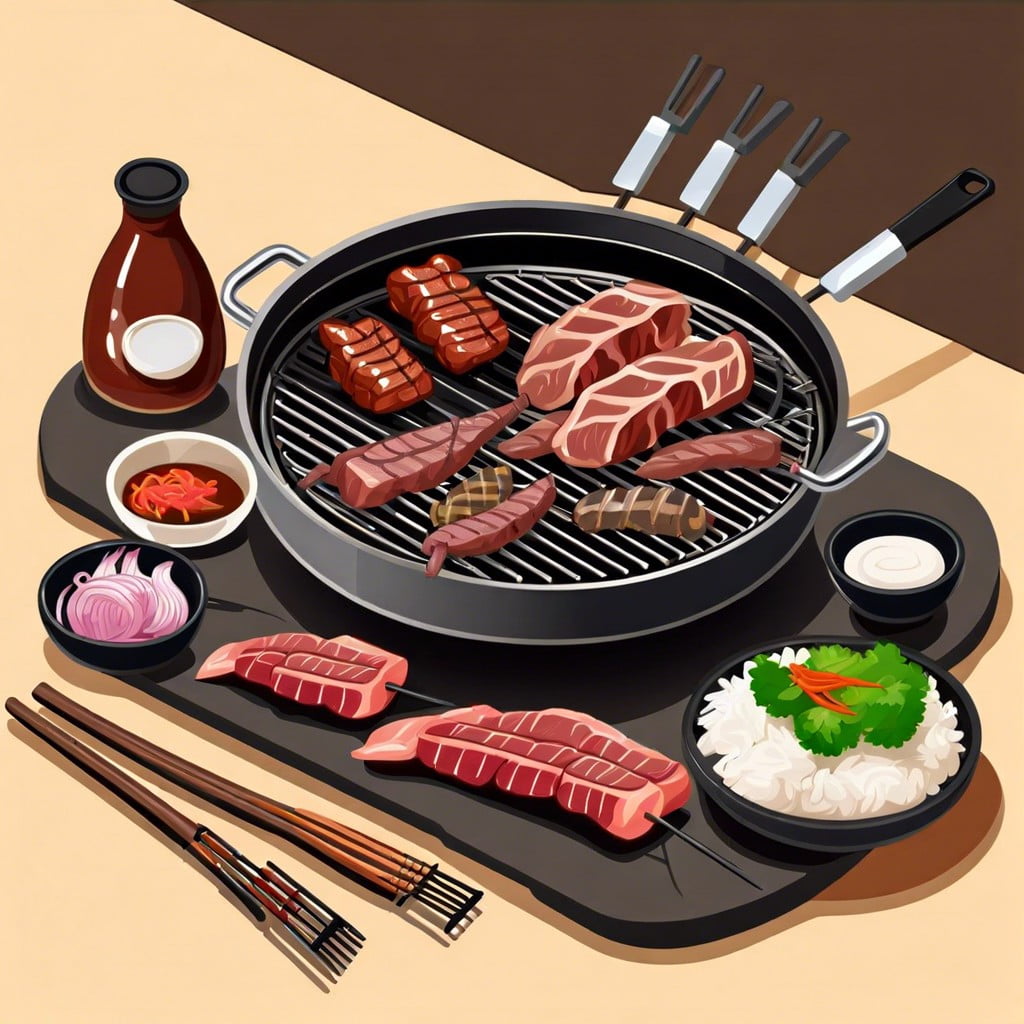Learn the essentials of preparing authentic Korean BBQ, from selecting meats to mastering the grill.
Key takeaways:
- Tabletop grill is essential for Korean BBQ experience.
- Thinly sliced cuts enhance marinade absorption and rapid cooking.
- Classic marinade includes soy sauce, sugar, garlic, and sesame oil.
- Banchan side dishes provide balance to the grilled meats.
- Use high heat, flip once, and let meat rest after grilling.
Essential Equipment for Korean BBQ

To host a traditional Korean BBQ at home, a tabletop grill is central to the experience. Gas or charcoal grills are suitable, but an electric version provides convenience and ease of use indoors. Round, portable designs mimic the authentic restaurant-style grilling.
Ensure you have tongs and scissors which are instrumental for turning and cutting the meat right on the grill. Opt for stainless steel varieties for their durability and ease of cleaning.
A range of small dishes or plates is crucial for serving banchan, the assortment of side dishes that accompany the grilled meats. Individual grilling plates or cast iron pans can also be used for items like kimchi and garlic.
Consider a ventilation solution if cooking indoors. A specially designed Korean BBQ exhaust system, or a regular kitchen extractor, helps to maintain a smoke-free environment.
Finally, traditional metal chopsticks and spoons round off the essentials, ensuring an authentic dining experience while handling the morsels of food with precision.
Selecting the Best Meats
The quality of meat has a profound impact on the flavors and textures of Korean BBQ. Opting for thinly sliced cuts is crucial – this allows rapid cooking on the grill and enhances marinade absorption.
When it comes to beef, look for ribeye or sirloin, ideally with marbling that ensures tenderness and juiciness. Pork belly is another staple, striking a balance of meat and fat which results in a succulent experience.
For those preferring chicken, the thigh is your best bet due to its richer flavor and moisture retention compared to breast meat. At your local butcher or Korean market, seek out cuts labeled specifically for Korean BBQ to guarantee the appropriate thickness.
Marinating Your Meats
The key to succulent Korean BBQ is a harmonious blend of sweet, savory, and umami flavors. Achieved through a rich marinade, the classic base combines soy sauce, sugar, pear juice, garlic, sesame oil, and a dash of black pepper. For variations, consider adding ingredients like kiwi or onion puree, which contain natural enzymes that tenderize the meat.
Marinade time matters. Beef bulgogi benefits from at least 30 minutes, but for optimal flavor infusion, leave it overnight in the refrigerator. Thinner cuts can be marinated for shorter periods, while thicker ones like galbi need longer to absorb the flavors fully.
With chicken or pork, be mindful not to overmarinate, especially if your mixture contains kiwi or pineapple, as the meats can become mushy. Aim for a maximum of two hours.
Finally, before grilling, let the meat sit at room temperature for about 20 minutes. This ensures even cooking and the full expression of marinated flavors on the heat.
Preparing Banchan Varieties
Banchan, an array of Korean side dishes, is a centerpiece of the Korean BBQ experience. It balances the grilled meats’ richness and provides a harmonious blend of flavors and textures. Traditional plates include kimchi, sweet and savory japgokbap (multigrain rice), and the refreshing mung bean pancake known as bindaetteok.
For a well-rounded banchan selection, include:
- Fermented dishes such as baechu-kimchi (cabbage kimchi) or kkakdugi (cubed radish kimchi) for tangy and spicy notes.
- Fresh, lightly seasoned vegetables like oi muchim (spicy cucumber salad) deliver a crisp contrast to heavier BBQ flavors.
- Japchae (stir-fried glass noodles with vegetables) serves as a sweet and savory chewy element.
- Protein-rich sides like myeolchi bokkeum (stir-fried anchovies) for those seeking a salty crunch.
- Danmuji (yellow pickled radish) provides a sweet, sour bite that cleanses the palate.
Prepare these dishes in advance, as they often require chilling and are typically served cold, harmonizing with the freshly grilled meats’ warmth. Consider the colors, textures, and flavors of your selections to craft a visually appealing and diverse banchan array. Aim for a balance of salty, sweet, sour, and bitter flavors to complement the umami-rich grilled meats.
Grilling Meat to Perfection
Achieving the ideal char without overcooking is pivotal. Use high heat for quick searing, which helps lock in the savory juices of thinly sliced meat. Monitor the temperature closely—Korean BBQ is interactive, and your vigilance will pay dividends in flavor.
Flip the meat only once, allowing the first side to develop a slightly crispy exterior. Watch for the edges to brown, usually signaling that it’s time to flip.
Remember, thin cuts cook rapidly; bulgogi may take only a minute per side, while thicker cuts like galbi might require a few minutes. Always use tongs, not forks, to avoid piercing the meat and releasing those precious juices.
Lastly, let the meat rest briefly after grilling; even a short rest period allows for the redistribution of juices, ensuring every bite is succulent.

